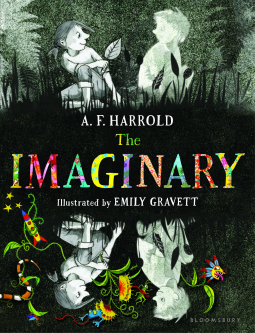 “THE IMAGINARY,” by A.F. Harrold and Emily Gravett, Bloomsbury USA Childrens, March 3, 2015, Hardcover, $16.99 (ages 8-12)
“THE IMAGINARY,” by A.F. Harrold and Emily Gravett, Bloomsbury USA Childrens, March 3, 2015, Hardcover, $16.99 (ages 8-12)
When he was little, my younger brother had an imaginary friend named Mimi. Mimi was a convenient person to pin actions on — if someone took a bite out of a pickle and put it back in the jar, Mimi did it. As my brother aged, Mimi slowly disappeared. That’s the nature of imaginary friends. But what if they really existed? “The Imaginary,” by A.F. Harrold and illustrated by Emily Gravett, tackles that question.
Rudger is Amanda Shuffleup’s imaginary friend, and — as with case of most imaginary friends — no one can see Rudger. No one else except the evil Mr. Bunting who hunts imaginaries and eats them. And now he’s found Rudger.
When an accident separates Rudger from Amanda, Rudger finds himself scared, alone and fading. He needs to find Amanda before she completely forgets him and before Mr. Bunting finds him.
The first chapter of “The Imaginary” is one of the better I’ve read in a while:
That evening Amanda Shuffleup opened her wardrobe door and hung her coat up on a boy.
She shut the door and sat down on her bed.
She hadn’t taken her shoes off before running upstairs and her feet were wet. It wasn’t just her feet, either. Her socks and shoes were soaked through too. Her shoes, and the laces.
The knots were cold and damp and hard and refused to come undone. She picked at them with her fingers, but that just hurt her nails. It felt like they’d pop off before the knot loosened.
If the laces never came undone, she thought, she’d never get her shoes off. And that meant she’d go through life with wet feet. Not only that, but wearing the same shoes forever. Amanda was the sort of girl (as she’d happily tell you) who liked wearing dirty old sneakers (because they’re comfy and it doesn’t matter if they get dirty because they’re already dirty), but even she could imagine a day, one day, when she might want to wear different shoes.
There’s more to the “shoe incident,” but you get the idea. It’s something we all can relate to. It’s imaginative. And it makes you want to know more about this girl.
I wish that all of “The Imaginary” lived up to that initial chapter, but it’s not that smooth throughout. In the beginning, it’s Amanda’s show. Rudger is pretty one note, and after a while, you start to wonder where the story is going. Fortunately, the tides turn, and Rudger becomes infinitely more interesting. Also, while the writing level and subject matter (imaginary friends) skews younger, the elements with Mr. Bunting are dark and lean toward a more mature middle reader.
